
|

|
|
Home Site Search Contact Us Subscribe
|
|
|
Poetry as Rescuing Angel: The Angel Island Immigration Station by Architectural Resources Group, Tom Eliot Fisch, and Daniel Quan Design Angel Island, San Francisco Bay: Long abandoned and near demolition, an important part of American immigration history was saved by writings on the wall. By ArchNewsNow June 21, 2011 The Angel Island Immigration Station has sometimes been referred to as the “Ellis Island of the West.” But it has a more complex history than its East Coast counterpart, which was a symbol of welcome to immigrants from all over. First operational in 1910, the Angel Island detention station controlled the flow of Chinese immigrants into the country in enforcement of the Chinese Exclusion Act of 1882. Over the next 30 years, the station served as the point of entry for approximately 175,000 Chinese, as well as immigrants from other countries. Some were detained for a year or more.
The detention of immigrants continues to be a hot-button issue, with the Obama Administration having promised an overhaul of the country’s often substandard detention facilities after deaths, abuse, and inadequate medical care in the system came to light. The Angel Island station – which reopened to the public in February 2009 after more than three years of restoration and preservation work – affords a valuable glimpse into the sometimes dark history of immigration – as well as the poetic testimonies that detainees left behind on its walls in response to their suffering.
That history was almost erased. The former administrative building burned down in 1940, and the station was abandoned. In 1941, the station became the north garrison of Fort McDowell, and the old detention barracks served as a prisoner of war processing center during World War II. Following the war, the station was again abandoned, and the buildings suffered neglect, vandalism, and decay. The California State Parks slated them for demolition in 1970.
First to go were the pier and wharf and what remained of the administration building. Staff cottages were deliberately burned during the filming of a fire scene in the Robert Redford movie The Candidate. As was discovered much later, these cottages had been designed by architect Julia Morgan, one of her earliest commissions – as it happened, she was sister-in-law to the commissioner of immigration at the time.
Only the detention barracks, the hospital building, and the powerhouse remained. Right before the barracks were to be demolished, a park ranger took a last walkthrough and saw carving on the walls. As a student at San Francisco State University, he recognized the writing as Asian and asked a professor of his to see if he could decipher it. The professor recognized the writing as Chinese poetry. (These poems were later translated and published in a book, Island Poetry and History of Chinese Immigrants on Angel Island, 1910-1940 by Him Mark Lai, Genny Lim, and Judy Yung.) The discovery saved the buildings from destruction and ultimately led to the formation of the Angel Island Immigration Station Foundation, a nonprofit organization that partners with the California State Parks and the National Park Service to preserve the site and educate people about its role in immigration history. The barracks opened to the public in 1983.
A number of those involved with the organization had relatives who had come through Angel Island. The foundation originally hired Daniel Quan, principal of Daniel Quan Design, to create a travelling exhibit about the island and the immigration station. “I got interested because my father was a detainee,” says Quan. “He came in 1926 from Canton, a farming region in southern China.” Quan ended up on the board of directors and then served as the foundation’s president, helping to launch a national campaign. The station attained National Historic Landmark status in 1997.
Another board member, Doug Tom, principal of local architecture firm Tom Eliot Fisch, became involved in 1999 – but was unaware for many years of his own family’s connection to the island. “I found out only within the last three years that my maternal grandparents came through this station,” he says. “I didn't think to ask. And for most detainees, their time here was a taboo subject all of their lives. It was not something they talked about.”
In the mid-1990s, the foundation hired local architecture firm Architectural Resources Group (ARG) to work with Quan on conducting a detailed investigation of the poems and create historic structure reports and reuse guidelines for the three existing buildings: the hospital, the barracks, and the powerhouse. The site was not in good shape – it had been overplanted with eucalyptus, which sucked all the water out of the ground. “There had been a lot of degradation of the stability of the slopes,” says Aaron Hyland, a managing principal at ARG. “When we came in, people thought that the whole hospital building was sliding down the hill. Also, water had damaged the walls, which were sagging. But it turned out not to require nearly as much work as was originally thought. As we found out when we did the stabilization, the building’s foundation hadn’t moved – the topping slab had just cracked, and the wall had shifted. And although water had rotted the wood walls, the entire roof structure was in great shape.”
The study of the poems turned up some surprises. “There were far more poems than we thought – double the number that had been recorded earlier,” Quan says. “Not all of the poems are easily visible. There are layers of paint, and some are really faint.”
Interestingly, immigration officials’ attempt to cover over the poetry played a hand in saving it for posterity. “We found correspondence between the superintendent of Angel Island and immigration officials in Washington, DC,” says Katherine Petrin, a senior associate at ARG. “The officials were unhappy with the poetry because it was defacing government property and because they thought it was leading to unrest. So on a couple of occasions, they ordered the detainees to stop carving poetry, and they puttied over everything and painted it out. This had the beneficial effect of preserving the carvings in a way that never would have happened otherwise. When the putty shrank, it made the carvings even more legible.”
Today, the foundation gives public tours of the restored detention barracks where the poetry was carved. “We didn't want to fix the barracks building so that it looked like new,” Quan explains. “We wanted to give people an experience that resembled what detainees might have had while they were there. So the condition of the walls is pretty much as it was in 1940. We wanted to freeze it in that state. And we put the bunks back in to give visitors an idea of how cramped a space it was with 600 people living there.”
Outside the detention barracks, an open space that follows the footprint of the former administration building exhibits information and documents about the building and its role in the detention station. Future phases will address the hospital and powerhouse.
The Angel Island Immigration Station tells a more complex story than the rosy story of the United States welcoming immigrants with open arms. “There has been a big change in the way that the state parks have told this side of history,” Quan says. “Now they are embracing that idea that there are other stories to be told, and that public parks are really good places to tell them.”
Project: Angel Island Immigration Station Restoration, Angel Island State Park, Tiburon, California Client: California State Parks, Marin District and Angel Island Immigration Station Foundation Architect: Architectural Resources Group, San Francisco, CA Associate Architect: Tom Eliot Fisch, San Francisco, CA Contractor: West Bay Builders, Novato, CA Consultants: Exhibit Design: Daniel Quan Design, Oakland, CA Landscape Architect: California State Parks, Sacramento, CA Structural Engineer: SOHA Engineers, San Francisco, CA Electrical Engineering: O’Mahony & Myer, San Rafael, CA Mechanical Engineering: Guttman & Blaevoet, San Francisco, CA Cost Estimator: Leland Saylor Associates, San Francisco, CA Hazardous Materials /Geotechnical: Winzler & Kelly, West Sacramento, CA Geotechnical Engineer: Fugro West, Oakland, CA Civil Engineer: Olivia Chen Consultants, Inc., San Francisco, CA Photographer: David Wakely Photography, San Francisco, CA
|
(click on pictures to enlarge) 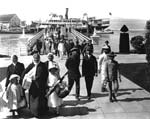 Department of Photographic Archives, State of California, Department of Parks and Recreation Immigrants arriving at Angel Island  Department of Photographic Archives, State of California, Department of Parks and Recreation Vintage photo of Angel Island Immigration Station, barracks building at right 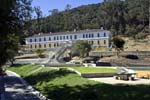 © David Wakely Restored barracks building and staircase. The new plaza occupies the footprint of the original administration building. 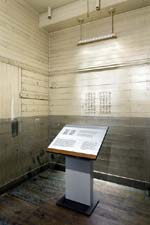 © David Wakely Interpretive display providing background about and translation of carved poetry. 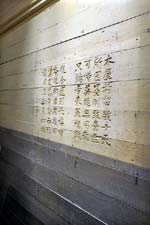 © David Wakely Detail of carved poetry. 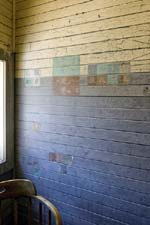 © David Wakely Detail of different materials used to obscure carved poetry. 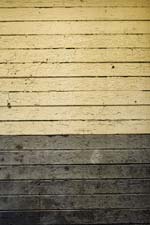 © David Wakely Detail of poetry that had been obscured. 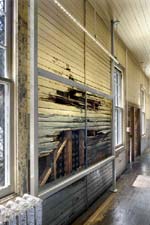 © David Wakely New glass panel recreates an original poem that was destroyed.  © David Wakely First floor of barracks building: a new interpretive display reuses poles from original barracks beds. 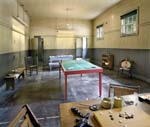 © David Wakely Recreated game room 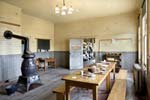 © David Wakely Recreated day room 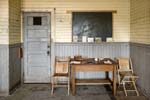 © David Wakely Day room detail 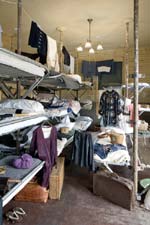 © David Wakely Recreation of women's barracks 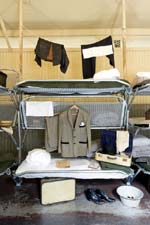 © David Wakely Recreation of men's barracks 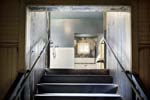 © David Wakely Stairway from men's barracks to men's showers 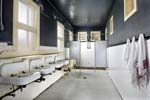 © David Wakely Men's showers |
© 2011 ArchNewsNow.com